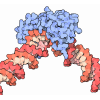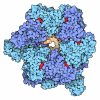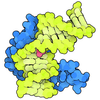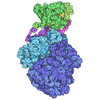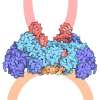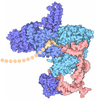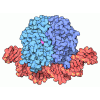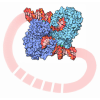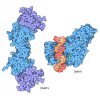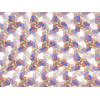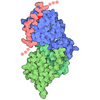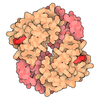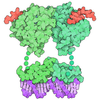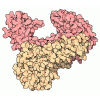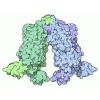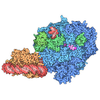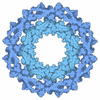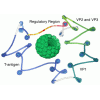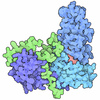+ Open data
Open data
- Basic information
Basic information
| Entry | Database: PDB / ID: 7scy | ||||||
|---|---|---|---|---|---|---|---|
| Title | Nuc147 bound to single BRCT | ||||||
 Components Components |
| ||||||
 Keywords Keywords | DNA BINDING PROTEIN/DNA / PARP1 / BRCT / nucleosome / DNA BINDING PROTEIN-DNA complex | ||||||
| Function / homology |  Function and homology information Function and homology informationNAD+-histone H2BS6 serine ADP-ribosyltransferase activity / NAD+-histone H3S10 serine ADP-ribosyltransferase activity / NAD+-histone H2BE35 glutamate ADP-ribosyltransferase activity / positive regulation of myofibroblast differentiation / negative regulation of ATP biosynthetic process / NAD+-protein-tyrosine ADP-ribosyltransferase activity / NAD+-protein-histidine ADP-ribosyltransferase activity / regulation of base-excision repair / positive regulation of single strand break repair / regulation of circadian sleep/wake cycle, non-REM sleep ...NAD+-histone H2BS6 serine ADP-ribosyltransferase activity / NAD+-histone H3S10 serine ADP-ribosyltransferase activity / NAD+-histone H2BE35 glutamate ADP-ribosyltransferase activity / positive regulation of myofibroblast differentiation / negative regulation of ATP biosynthetic process / NAD+-protein-tyrosine ADP-ribosyltransferase activity / NAD+-protein-histidine ADP-ribosyltransferase activity / regulation of base-excision repair / positive regulation of single strand break repair / regulation of circadian sleep/wake cycle, non-REM sleep / vRNA Synthesis / carbohydrate biosynthetic process / NAD+-protein-serine ADP-ribosyltransferase activity / negative regulation of adipose tissue development / NAD DNA ADP-ribosyltransferase activity / DNA ADP-ribosylation / mitochondrial DNA metabolic process / regulation of oxidative stress-induced neuron intrinsic apoptotic signaling pathway / replication fork reversal / ATP generation from poly-ADP-D-ribose / positive regulation of necroptotic process / transcription regulator activator activity / response to aldosterone / HDR through MMEJ (alt-NHEJ) / positive regulation of DNA-templated transcription, elongation / NAD+ ADP-ribosyltransferase / signal transduction involved in regulation of gene expression / negative regulation of telomere maintenance via telomere lengthening / protein auto-ADP-ribosylation / mitochondrial DNA repair / NAD+-protein-aspartate ADP-ribosyltransferase activity / protein poly-ADP-ribosylation / positive regulation of intracellular estrogen receptor signaling pathway / negative regulation of cGAS/STING signaling pathway / positive regulation of cardiac muscle hypertrophy / NAD+-protein-glutamate ADP-ribosyltransferase activity / positive regulation of mitochondrial depolarization / cellular response to zinc ion / NAD+-protein mono-ADP-ribosyltransferase activity / nuclear replication fork / decidualization / protein autoprocessing / R-SMAD binding / site of DNA damage / negative regulation of transcription elongation by RNA polymerase II / NAD+ poly-ADP-ribosyltransferase activity / macrophage differentiation / Transferases; Glycosyltransferases; Pentosyltransferases / positive regulation of SMAD protein signal transduction / POLB-Dependent Long Patch Base Excision Repair / negative regulation of tumor necrosis factor-mediated signaling pathway / negative regulation of megakaryocyte differentiation / SUMOylation of DNA damage response and repair proteins / protein localization to CENP-A containing chromatin / positive regulation of double-strand break repair via homologous recombination / Chromatin modifying enzymes / nucleosome binding / Replacement of protamines by nucleosomes in the male pronucleus / CENP-A containing nucleosome / Packaging Of Telomere Ends / protein localization to chromatin / Recognition and association of DNA glycosylase with site containing an affected purine / Cleavage of the damaged purine / Deposition of new CENPA-containing nucleosomes at the centromere / Recognition and association of DNA glycosylase with site containing an affected pyrimidine / Cleavage of the damaged pyrimidine / nucleotidyltransferase activity / telomere organization / telomere maintenance / Interleukin-7 signaling / Inhibition of DNA recombination at telomere / RNA Polymerase I Promoter Opening / transforming growth factor beta receptor signaling pathway / Meiotic synapsis / Assembly of the ORC complex at the origin of replication / negative regulation of innate immune response / Regulation of endogenous retroelements by the Human Silencing Hub (HUSH) complex / SUMOylation of chromatin organization proteins / DNA methylation / epigenetic regulation of gene expression / Condensation of Prophase Chromosomes / Chromatin modifications during the maternal to zygotic transition (MZT) / SIRT1 negatively regulates rRNA expression / HCMV Late Events / nuclear estrogen receptor binding / innate immune response in mucosa / ERCC6 (CSB) and EHMT2 (G9a) positively regulate rRNA expression / PRC2 methylates histones and DNA / response to gamma radiation / Regulation of endogenous retroelements by KRAB-ZFP proteins / Defective pyroptosis / mitochondrion organization / HDACs deacetylate histones / Regulation of endogenous retroelements by Piwi-interacting RNAs (piRNAs) / Nonhomologous End-Joining (NHEJ) / lipopolysaccharide binding / enzyme activator activity / RNA Polymerase I Promoter Escape / Downregulation of SMAD2/3:SMAD4 transcriptional activity / Transcriptional regulation by small RNAs Similarity search - Function | ||||||
| Biological species |  Homo sapiens (human) Homo sapiens (human) | ||||||
| Method | ELECTRON MICROSCOPY / single particle reconstruction / cryo EM / Resolution: 4.1 Å | ||||||
 Authors Authors | Muthurajan, U.M. / Rudolph, J.R. | ||||||
| Funding support |  United States, 1items United States, 1items
| ||||||
 Citation Citation |  Journal: Mol Cell / Year: 2021 Journal: Mol Cell / Year: 2021Title: The BRCT domain of PARP1 binds intact DNA and mediates intrastrand transfer. Authors: Johannes Rudolph / Uma M Muthurajan / Megan Palacio / Jyothi Mahadevan / Genevieve Roberts / Annette H Erbse / Pamela N Dyer / Karolin Luger /  Abstract: PARP1 is a key player in the response to DNA damage and is the target of clinical inhibitors for the treatment of cancers. Binding of PARP1 to damaged DNA leads to activation wherein PARP1 uses NAD ...PARP1 is a key player in the response to DNA damage and is the target of clinical inhibitors for the treatment of cancers. Binding of PARP1 to damaged DNA leads to activation wherein PARP1 uses NAD to add chains of poly(ADP-ribose) onto itself and other nuclear proteins. PARP1 also binds abundantly to intact DNA and chromatin, where it remains enzymatically inactive. We show that intact DNA makes contacts with the PARP1 BRCT domain, which was not previously recognized as a DNA-binding domain. This binding mode does not result in the concomitant reorganization and activation of the catalytic domain. We visualize the BRCT domain bound to nucleosomal DNA by cryogenic electron microscopy and identify a key motif conserved from ancestral BRCT domains for binding phosphates on DNA and phospho-peptides. Finally, we demonstrate that the DNA-binding properties of the BRCT domain contribute to the "monkey-bar mechanism" that mediates DNA transfer of PARP1. | ||||||
| History |
|
- Structure visualization
Structure visualization
| Movie |
 Movie viewer Movie viewer |
|---|---|
| Structure viewer | Molecule:  Molmil Molmil Jmol/JSmol Jmol/JSmol |
- Downloads & links
Downloads & links
- Download
Download
| PDBx/mmCIF format |  7scy.cif.gz 7scy.cif.gz | 528.4 KB | Display |  PDBx/mmCIF format PDBx/mmCIF format |
|---|---|---|---|---|
| PDB format |  pdb7scy.ent.gz pdb7scy.ent.gz | 416.8 KB | Display |  PDB format PDB format |
| PDBx/mmJSON format |  7scy.json.gz 7scy.json.gz | Tree view |  PDBx/mmJSON format PDBx/mmJSON format | |
| Others |  Other downloads Other downloads |
-Validation report
| Summary document |  7scy_validation.pdf.gz 7scy_validation.pdf.gz | 842.1 KB | Display |  wwPDB validaton report wwPDB validaton report |
|---|---|---|---|---|
| Full document |  7scy_full_validation.pdf.gz 7scy_full_validation.pdf.gz | 914.6 KB | Display | |
| Data in XML |  7scy_validation.xml.gz 7scy_validation.xml.gz | 40 KB | Display | |
| Data in CIF |  7scy_validation.cif.gz 7scy_validation.cif.gz | 64.6 KB | Display | |
| Arichive directory |  https://data.pdbj.org/pub/pdb/validation_reports/sc/7scy https://data.pdbj.org/pub/pdb/validation_reports/sc/7scy ftp://data.pdbj.org/pub/pdb/validation_reports/sc/7scy ftp://data.pdbj.org/pub/pdb/validation_reports/sc/7scy | HTTPS FTP |
-Related structure data
| Related structure data |  25042MC 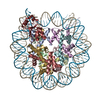 7sczC M: map data used to model this data C: citing same article ( |
|---|---|
| Similar structure data |
- Links
Links
- Assembly
Assembly
| Deposited unit | 
|
|---|---|
| 1 |
|
- Components
Components
-DNA chain , 2 types, 2 molecules IJ
| #1: DNA chain | Mass: 45610.043 Da / Num. of mol.: 1 / Source method: obtained synthetically / Source: (synth.)  Homo sapiens (human) Homo sapiens (human) |
|---|---|
| #2: DNA chain | Mass: 45138.770 Da / Num. of mol.: 1 / Source method: obtained synthetically / Source: (synth.)  Homo sapiens (human) Homo sapiens (human) |
-Protein , 5 types, 9 molecules AEBFCGDHK
| #3: Protein | Mass: 15719.445 Da / Num. of mol.: 2 Source method: isolated from a genetically manipulated source Source: (gene. exp.)  Homo sapiens (human) Homo sapiens (human)Gene: H3C1, H3FA, HIST1H3A, H3C2, H3FL, HIST1H3B, H3C3, H3FC HIST1H3C, H3C4, H3FB, HIST1H3D, H3C6, H3FD, HIST1H3E, H3C7, H3FI, HIST1H3F, H3C8, H3FH, HIST1H3G, H3C10, H3FK, HIST1H3H, H3C11, H3FF, ...Gene: H3C1, H3FA, HIST1H3A, H3C2, H3FL, HIST1H3B, H3C3, H3FC HIST1H3C, H3C4, H3FB, HIST1H3D, H3C6, H3FD, HIST1H3E, H3C7, H3FI, HIST1H3F, H3C8, H3FH, HIST1H3G, H3C10, H3FK, HIST1H3H, H3C11, H3FF, HIST1H3I, H3C12, H3FJ, HIST1H3J Production host:  #4: Protein | Mass: 11676.703 Da / Num. of mol.: 2 Source method: isolated from a genetically manipulated source Source: (gene. exp.)  Homo sapiens (human) Homo sapiens (human)Gene: H4C1, H4/A, H4FA, HIST1H4A, H4C2, H4/I, H4FI, HIST1H4B, H4C3, H4/G, H4FG, HIST1H4C, H4C4, H4/B, H4FB, HIST1H4D, H4C5, H4/J, H4FJ, HIST1H4E, H4C6, H4/C, H4FC, HIST1H4F, H4C8, H4/H, H4FH, ...Gene: H4C1, H4/A, H4FA, HIST1H4A, H4C2, H4/I, H4FI, HIST1H4B, H4C3, H4/G, H4FG, HIST1H4C, H4C4, H4/B, H4FB, HIST1H4D, H4C5, H4/J, H4FJ, HIST1H4E, H4C6, H4/C, H4FC, HIST1H4F, H4C8, H4/H, H4FH, HIST1H4H, H4C9, H4/M, H4FM, HIST1H4I, H4C11, H4/E, H4FE, HIST1H4J, H4C12, H4/D, H4FD, HIST1H4K, H4C13, H4/K, H4FK, HIST1H4L, H4C14, H4/N, H4F2, H4FN, HIST2H4, HIST2H4A, H4C15, H4/O, H4FO, HIST2H4B, H4-16, HIST4H4 Production host:  #5: Protein | Mass: 14447.825 Da / Num. of mol.: 2 Source method: isolated from a genetically manipulated source Source: (gene. exp.)  Homo sapiens (human) / Gene: HIST1H2AB, HIST1H2AE, hCG_1640984, hCG_1787383 / Production host: Homo sapiens (human) / Gene: HIST1H2AB, HIST1H2AE, hCG_1640984, hCG_1787383 / Production host:  #6: Protein | Mass: 14217.516 Da / Num. of mol.: 2 Source method: isolated from a genetically manipulated source Source: (gene. exp.)  Homo sapiens (human) / Gene: HIST1H2BJ, H2BFR / Production host: Homo sapiens (human) / Gene: HIST1H2BJ, H2BFR / Production host:  #7: Protein | | Mass: 14337.548 Da / Num. of mol.: 1 Source method: isolated from a genetically manipulated source Source: (gene. exp.)  Homo sapiens (human) / Gene: PARP1, ADPRT, PPOL / Production host: Homo sapiens (human) / Gene: PARP1, ADPRT, PPOL / Production host:  References: UniProt: P09874, NAD+ ADP-ribosyltransferase, Transferases; Glycosyltransferases; Pentosyltransferases |
|---|
-Experimental details
-Experiment
| Experiment | Method: ELECTRON MICROSCOPY |
|---|---|
| EM experiment | Aggregation state: PARTICLE / 3D reconstruction method: single particle reconstruction |
- Sample preparation
Sample preparation
| Component | Name: Nuc147-PARP1-BRCT / Type: COMPLEX / Entity ID: all / Source: MULTIPLE SOURCES |
|---|---|
| Molecular weight | Value: 0.214 MDa / Experimental value: NO |
| Source (natural) | Organism:  Homo sapiens (human) Homo sapiens (human) |
| Source (recombinant) | Organism:  |
| Buffer solution | pH: 7.5 |
| Specimen | Embedding applied: NO / Shadowing applied: NO / Staining applied: NO / Vitrification applied: YES |
| Vitrification | Cryogen name: ETHANE |
- Electron microscopy imaging
Electron microscopy imaging
| Experimental equipment |  Model: Titan Krios / Image courtesy: FEI Company |
|---|---|
| Microscopy | Model: FEI TITAN KRIOS |
| Electron gun | Electron source:  FIELD EMISSION GUN / Accelerating voltage: 300 kV / Illumination mode: OTHER FIELD EMISSION GUN / Accelerating voltage: 300 kV / Illumination mode: OTHER |
| Electron lens | Mode: OTHER |
| Image recording | Electron dose: 60 e/Å2 / Film or detector model: GATAN K3 (6k x 4k) |
- Processing
Processing
| CTF correction | Type: NONE |
|---|---|
| 3D reconstruction | Resolution: 4.1 Å / Resolution method: FSC 0.143 CUT-OFF / Num. of particles: 16495 / Symmetry type: POINT |
 Movie
Movie Controller
Controller




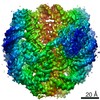

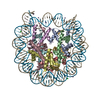
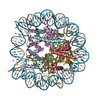
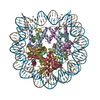
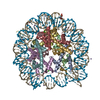

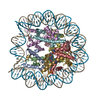


 PDBj
PDBj